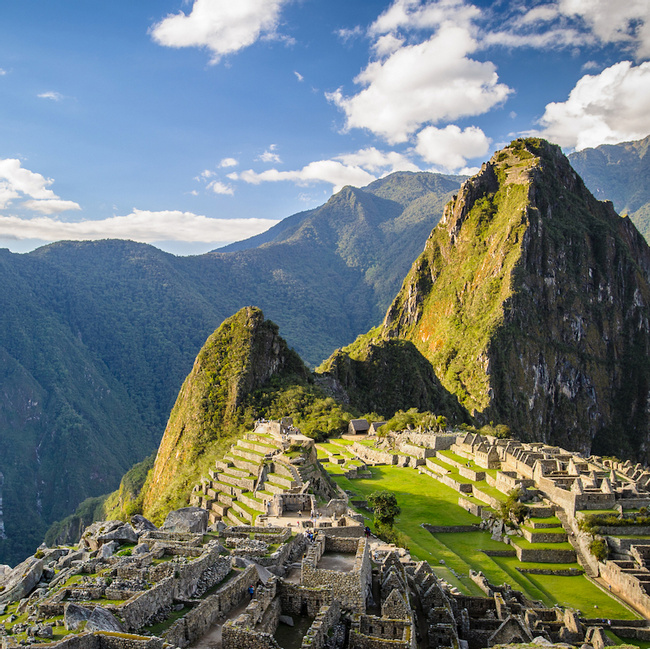- Travel Guides
Money in Peru
Peru’s official currency is the nuevo sol (S/.), which tends to hover around 2.80 sol per $1 USD. There are paper bills with denominations of 10, 20, 50, 100, and 200 soles. Coins come in denominations of 1, 5, 10, 20 and 50 céntimos, with 100 céntimos equaling 1 sol. There are also larger coins of 1, 2, and 5 soles. Exchange rates are often listed in front of banks.

Practical Matters
Money in Peru is fairly straightforward. The following information will help you prepare to budget, spend, and save money in Peru.
Costs
Peru caters to all kinds budgets, from the thrifty backpackers to luxury loving wanderers. Travelers that want some level of comfort–including good food and hotels with hot water–will likely spend about USD $70 USD to $100 USD a day. If you’re interested in staying in high end hotels and eating at quality restaurants, you may spend up to several hundred dollars a day.
There are several ways to save money while traveling in Peru. Sharing a room is an easy one, as is ordering set meals from restaurants instead of à la carte options. Paying with cash will save you surcharges from your bank, and bargaining can be beneficial at markets and in taxicabs.
Banks and ATMs
ATMs (cajeros automáticos) are plentiful in Peru, especially in popular destinations. ATMs make it easy and cheap to get cash in Peru. U.S. banks typically charge a transaction fee, which usually is about $3 USD to $5 USD per transaction. Most ATMs accept both Visa and MasterCard; Global Net and Banco de Crédito are the only machines that accept American Express.
Do note, however, that ATMs in Peru first deliver your cash and then return your card. Don’t forget to take your card or it will be pulled back into the machine and become a real pain to get out.
Banks are located throughout the country and are usually open from 9:00 a.m. to 5:00 p.m. Monday-Friday, and on Saturday mornings. Travelers can use Peruvian banks to receive wire transfers, cash travelers checks, and get cash advances on credit cards.
Changing Money
Money can be exchanged at banks and exchange houses, both of which are found in most cities and airports. The exchange houses, known as casas de cambio, typically have slightly higher rates than banks. Representatives of these exchange houses will sometimes come to your hotel to exchange money.
You will also see money changers on the streets in major cities—you’ll be able to pick them out by their vest and ID card. They are usually a safe way to change money, but it’s still a good idea to know the daily exchange rate just in case they try to take advantage of you.
Never change money with unlicensed money changers and be sure to check soles to make sure they are not ripped or counterfeit. Also, try to get 20- and 50-sole bills, as larger denominations can sometimes be hard to use.
Peru's economy is rapidly growing, which lends strength to the nuevo sol. Additionally, the fact that the Peruvian government is stable means that you should not have to worry about dramatic swings in the exchange rate during the duration of your trip.
Credit Cards
The use of [credit cards] (/peru/questions/money-budgeting/are-credit-cards-accepted) is becoming more widespread in Peru, especially in larger cities where they can be used to purchase almost everything. Visa tends to be the easiest credit card to use in hotels and restaurants, although some places will also accept American Express and MasterCard. You will typically be unable to use credit cards in smaller cities and more remote areas. Have cash on hand while traveling to such places.
Travelers Checks
Banks may charge a large fee for cashing travelers checks, but it’s still a good idea to have a few with you just in case your credit or debit cards are stolen. American Express is the most widely accepted kind. If you end up not using your travelers checks, you can always convert them into cash when you return home.
Tipping
Tipping is not required in most instances, but is still a good way of expressing gratitude and putting money into the pockets of people who may really need it.
Try to tip with the local currency, as some people may not have easy access to exchange houses. Even small tips are appreciated.
In restaurants, it’s common to tip 10 percent. You don’t need to tip taxi drivers, but it’s a good idea to tip a few soles to tour guides, porters, and people who help you with luggage.
Bargaining
Bargaining is common in Peru, especially in shops and markets. Don’t go overboard, though—it’s best to offer a price about 20 percent less than what you’re quoted. Vendors and shoppers usually meet in the middle.
We believe travel is more than ticking destinations off a list – it’s about discovering new places deeply, feeling connected wherever you go, and knowing you have a trusted team behind you every step of the way.



